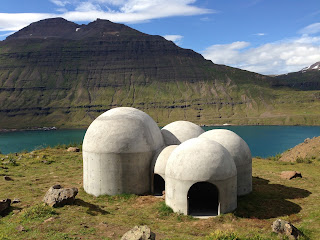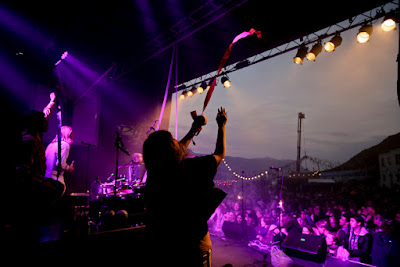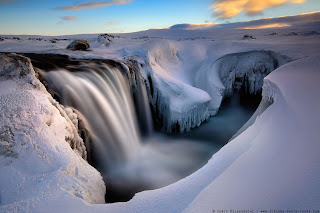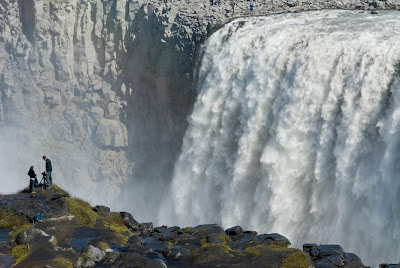Seyðisfjörður town is situated in a fjord with the same name, in the east of Iceland. Founded by Norwegian fishermen in 1895, this little town is noted for its Norwegian-style wooden houses that are homes to 700 inhabitants, who survive mainly on fishing and tourism. Seyðisfjörður is also the main ferry port to and from Denmark.
Seyðisfjörður is renowned for its numerous beautiful waterfalls, that follow the Fjarðará river, and can be admired when coming from Egilsstaðir via route 93.
Seyðisfjörður is especially popular for its growing artist community. The Skaftfell centre of visual arts offers exhibitions, art discussions and artist residencies to those who wish to stay throughout the year.
The LungA festival, which takes place every year in July, brings together artists from all over Iceland and the world, and celebrates creativity through performances, shows and concerts.
The LungA festival began in 2000, and in 2010 a school with the same name was established in order to promote personal development in various artistic activities. The school program consists of 12 weeks of artistic discovery and teaching. If you have an artistic streak, there are plenty of opportunities to stay long-term or short-term in Seyðisfjörður.
Seyðisfjörður is also known for its clever installation piece Tvísöngur, by Berlin artist Lukas Kühne, which can be seen twenty minutes walking distance from the Brimberg fish factory. Tvísöngur is a collection of five large stone domes that pays tribute to Iceland's unique musical tradition of five-tone harmonies. Once inside visitors can experience each dome as a musical instrument, because when the wind blows through a dome, it creates a sound, each dome resonating a different tone that makes up a five tone harmony.
A visit to the town would feel incomplete without seeing Bláa Kirkjan, the little blue church in Seyðisfjörður. In addition to being picturesque and charming, the church is also known for the Blue Church Summer Concert Series (started 1998), when the town's folk organise a concert in the church every Wednesday evening from around July 1st - August 12th, all genres of music can be heard i.e. blues, folk, jazz and classical music, in a warm and relaxing atmosphere.
Art is not the only attraction in Seyðisfjörður. Depending on the season, one can choose from many outdoor activities i.e. fishing, diving, paragliding, skiing, golfing, kayaking and hiking. If you wish to do something inside, you can visit the technical museum or the Fjardasel power plant.
The Skálanes nature reserve is found just twenty kilometers from Seyðisfjörður and is owned and managed by Ólafur Pétursson and his family, working alongside a variety of staff from the local community and abroad. The people at Skálanes are working towards making the nature reserve more sustainable through agriculture and also manufacture quilts, brew beer and make honey.
Joanne, Iceland24
November 2015
Popular waterfalls in the north of Iceland
Goðafoss (the waterfall of the Gods), 12 meters high and 30 meters wide, is located on the number 1 route between Akureyri and Myvatn, on the Skjálfandafljót glacier river. This magnificent waterfall is connected to an important event in Icelandic history; that is, in the year 1000, when the Icelandic parliament rejected Paganism in favour of Christianity as the official religion, Þorgeir Þorkellsson (the law speaker of the Icelandic parliament) threw statues of Pagan gods into the Goðafoss waterfall to symbolise the conversion.
Aldeyjarfoss is based in the Barðardal valley at the start of the Sprengisandur road. At this spectacular waterfall you’ll see a contrast between the white gushing water from the Skjálfandafjót glacier river and the dark basalt stone columns surrounding its 20-meter drop. This is definitely a sight to have your camera ready for!
Ullarfoss is situated in a river that runs across the Bárðardal valley, joining the Sudura valley and then continues to flow into the Skjálfandafljót glacier river.
Hrafnabjargafoss like the three previous waterfalls emerges from several canyons on the Skjálfandafljót glacier river. Hrafnabjargafoss possesses an incomparable beauty, especially in winter time, and yet, not many travelers know it exists. Once stumbled upon, it captivates both amateur and professional photographers alike. If you decide to explore the surrounding area a little, you will discover many other waterfalls, such as Ingvararfoss, Fiskárfoss or Glæfra.
Selfoss is not so high (11 meters), but is intensely strong and wide. This adorable waterfall is situated upstream from the glorious Dettifoss waterfall and marks the beginning of the Jökulsá gorge (Jökulsárgljúfur in Icelandic).
Dettifoss is situated 308 meters above sea level in one of the canyons of the river Jökulsá at Fjöllum, a river resulting from the melting of the Vatnajökull glacier. Dettifoss is perhaps the most popular waterfall in Iceland, and the most powerful waterfall in Europe because it is 100 meters wide, 45 meters high, and flows at an impressive speed. Dettifoss is found in the Vatnajökull national park and has become a movie attraction when it appeared in the opening scene of the film “Prometheus” by Ridley Scott.
Hafragilsfoss is located 2 kilometres downstream from the mighty Dettifoss waterfall, meeting the glacier river Jökulsá at Fjöllum at a 27-meter drop. Hafragilsfoss pours down volumes of water at a forceful speed and this you can see from both sides of the river. The series of impressive waterfalls comprising of Selfoss, Dettifoss and Hafragilsfoss is a must see for any one wishing to have a full-on waterfall experience.
Safety advice for lovers of Icelandic waterfalls
The summer of 2015 has seen a rise in tourism in Iceland, and a rise in incidences involving visitors unaware of the dangers of getting too close to the edge of steep waterfalls. Yes! Icelandic nature is powerful and energetic, but also let’s not forget to respect that it’s sometimes fragile too. There is still very little infrastructure around the waterfall sites listed above. Pathways and fences are few, so please be careful! and remember! that “no fence” is not an invitation to get as near as you wish. Take in the lovely view of course… but not too closely!
Joanne, Iceland24
November 2015
Aldeyjarfoss is based in the Barðardal valley at the start of the Sprengisandur road. At this spectacular waterfall you’ll see a contrast between the white gushing water from the Skjálfandafjót glacier river and the dark basalt stone columns surrounding its 20-meter drop. This is definitely a sight to have your camera ready for!
Ullarfoss is situated in a river that runs across the Bárðardal valley, joining the Sudura valley and then continues to flow into the Skjálfandafljót glacier river.
Hrafnabjargafoss like the three previous waterfalls emerges from several canyons on the Skjálfandafljót glacier river. Hrafnabjargafoss possesses an incomparable beauty, especially in winter time, and yet, not many travelers know it exists. Once stumbled upon, it captivates both amateur and professional photographers alike. If you decide to explore the surrounding area a little, you will discover many other waterfalls, such as Ingvararfoss, Fiskárfoss or Glæfra.
Selfoss is not so high (11 meters), but is intensely strong and wide. This adorable waterfall is situated upstream from the glorious Dettifoss waterfall and marks the beginning of the Jökulsá gorge (Jökulsárgljúfur in Icelandic).
Dettifoss is situated 308 meters above sea level in one of the canyons of the river Jökulsá at Fjöllum, a river resulting from the melting of the Vatnajökull glacier. Dettifoss is perhaps the most popular waterfall in Iceland, and the most powerful waterfall in Europe because it is 100 meters wide, 45 meters high, and flows at an impressive speed. Dettifoss is found in the Vatnajökull national park and has become a movie attraction when it appeared in the opening scene of the film “Prometheus” by Ridley Scott.
Hafragilsfoss is located 2 kilometres downstream from the mighty Dettifoss waterfall, meeting the glacier river Jökulsá at Fjöllum at a 27-meter drop. Hafragilsfoss pours down volumes of water at a forceful speed and this you can see from both sides of the river. The series of impressive waterfalls comprising of Selfoss, Dettifoss and Hafragilsfoss is a must see for any one wishing to have a full-on waterfall experience.
Safety advice for lovers of Icelandic waterfalls
The summer of 2015 has seen a rise in tourism in Iceland, and a rise in incidences involving visitors unaware of the dangers of getting too close to the edge of steep waterfalls. Yes! Icelandic nature is powerful and energetic, but also let’s not forget to respect that it’s sometimes fragile too. There is still very little infrastructure around the waterfall sites listed above. Pathways and fences are few, so please be careful! and remember! that “no fence” is not an invitation to get as near as you wish. Take in the lovely view of course… but not too closely!
Joanne, Iceland24
November 2015
A journey into the Heart of Iceland’s music festivals
Every year Iceland hosts dozens of music festivals, both in summer and in winter. Below is a concise list of music festivals in Iceland, showing you exactly where to go to discover the gems of International and Icelandic music.
Sónar Reykjavík offers you the best concerts/DJs in electronic music combined with audiovisual productions from Iceland, and from around the globe. For 3 nights, on 5 stages and with over 70 artists and bands, the prestigious Harpa Venue transforms into a massive nightclub where creative expression through dance is a certainty.
Reykjavík Blues Festival takes place at the end of March. The festival opens with blues concerts in downtown Reykjavík on the first day, which is then followed by blues festivities and concerts at the Hilton Nordica Hotel.
Aldrei fór ég suður (I never went south), was set up in 2004 by Mugison, an Icelandic musician. The festival takes place in Isafjörður, in the Westfjords, where Mugison lives, and welcomes the best of Icelandic music. One year Sigur Rós showed up in cowboy hats and performed hillbilly versions of all their old tunes. All concerts are free of charge!
Secret Solstice festival first took place in June 2014. With Massive Attack performing last year, and Wu-Tang Clan this year 2015, the festival immediately became a major popular event. The Secret Solstice is situated in the Laugardalur valley in Reykjavík; it’s been nicknamed Festival of the Midnight Sun, because it takes place over the summer solstice weekend... 72 hours of music, and the sun that doesn’t set... quite a program!
Við Djúpið also happens around the time of the summer solstice, in Isafjörður in the Westfjords. This festival is organised in co-operation with the Iceland Academy of Arts. Traditional music and classical music are on the program, and the festival offers lessons and workshops by renowned musicians.
Eistnaflug is a metal music festival running since 2005 at Neskaupstaður and hosts the most popular unsigned metal bands (most of them Icelandic).With more than thirty groups on the agenda, this festival doubles the population of this small town in the Eastfjords.
Siglufjörður (folk music festival) begins on the first Wednesday of July and offers concerts, conferences and workshops to promote traditional Icelandic music and Icelandic instruments. Steindór Andersen and Sigur Rós made a noticeable appearance there in 2009.
The British festival ATP (All Tomorrow’s Parties), were invited in 2013, to the old military base of Ásbrú, close to Keflavík, and return every year for a few days at the beginning of July. Good quality International bands (Belle & Sebastian, Public Enemy, Portishead, Mogwai, Nick Cave & The Bad Seeds) performed at ATP, as well as upcoming local bands. Amazing concerts, cinema, DJs and other activities have made ATP successful for three years in a row.
Iceland Airwaves is without a doubt the most well-known and most popular festival in Iceland. With more than 100 groups and musicians on the program, this festival attracts travellers from all over the world. For five days in November, downtown Reykjavík vibrates to the sound waves of the festival and music can be heard everywhere!
Joanne, Iceland24
November 2015
Sónar Reykjavík offers you the best concerts/DJs in electronic music combined with audiovisual productions from Iceland, and from around the globe. For 3 nights, on 5 stages and with over 70 artists and bands, the prestigious Harpa Venue transforms into a massive nightclub where creative expression through dance is a certainty.
Reykjavík Blues Festival takes place at the end of March. The festival opens with blues concerts in downtown Reykjavík on the first day, which is then followed by blues festivities and concerts at the Hilton Nordica Hotel.
Aldrei fór ég suður (I never went south), was set up in 2004 by Mugison, an Icelandic musician. The festival takes place in Isafjörður, in the Westfjords, where Mugison lives, and welcomes the best of Icelandic music. One year Sigur Rós showed up in cowboy hats and performed hillbilly versions of all their old tunes. All concerts are free of charge!
Secret Solstice festival first took place in June 2014. With Massive Attack performing last year, and Wu-Tang Clan this year 2015, the festival immediately became a major popular event. The Secret Solstice is situated in the Laugardalur valley in Reykjavík; it’s been nicknamed Festival of the Midnight Sun, because it takes place over the summer solstice weekend... 72 hours of music, and the sun that doesn’t set... quite a program!
Við Djúpið also happens around the time of the summer solstice, in Isafjörður in the Westfjords. This festival is organised in co-operation with the Iceland Academy of Arts. Traditional music and classical music are on the program, and the festival offers lessons and workshops by renowned musicians.
Eistnaflug is a metal music festival running since 2005 at Neskaupstaður and hosts the most popular unsigned metal bands (most of them Icelandic).With more than thirty groups on the agenda, this festival doubles the population of this small town in the Eastfjords.
Siglufjörður (folk music festival) begins on the first Wednesday of July and offers concerts, conferences and workshops to promote traditional Icelandic music and Icelandic instruments. Steindór Andersen and Sigur Rós made a noticeable appearance there in 2009.
The British festival ATP (All Tomorrow’s Parties), were invited in 2013, to the old military base of Ásbrú, close to Keflavík, and return every year for a few days at the beginning of July. Good quality International bands (Belle & Sebastian, Public Enemy, Portishead, Mogwai, Nick Cave & The Bad Seeds) performed at ATP, as well as upcoming local bands. Amazing concerts, cinema, DJs and other activities have made ATP successful for three years in a row.
Iceland Airwaves is without a doubt the most well-known and most popular festival in Iceland. With more than 100 groups and musicians on the program, this festival attracts travellers from all over the world. For five days in November, downtown Reykjavík vibrates to the sound waves of the festival and music can be heard everywhere!
Joanne, Iceland24
November 2015
The Ring Road in Iceland (Route 1)
Route 1, also known as the Ring Road, is the major highway in Iceland connecting most of the towns, including Reykjavík, the capital and only city. It is 830 miles long (1330 km) and goes through the fjords, mountains, plateaus and flat land. Because Route 1 is the only road connecting east to west in Iceland, travelers should take precautions when crossing the country.
Marketers in Reykjanes, Snæfellsnes, the Westfjords and the far northeast of Iceland often complain that sticking to the ring road means you miss some of the country’s greatest pearls – and that is undeniably true. On the other hand, you also drive right through some of the country’s greatest pearls and it is an excellent first-time introduction to Iceland before you return to the country again, and again (hopefully).
The many amazing highlights of the ring road experience include some of the biggest towns in the country, some of the most sought-after waterfalls in Europe, the Eyjafjallajökull and Vatnajökull glaciers, the Jökulsárlón glacial lagoon…and that’s just on the south coast alone!
There are already articles about the major attractions in South Iceland, East Iceland, North Iceland and West Iceland on this site, so we won’t dwell on them too much here. Suffice is to say simply that you won’t run short of things to see and do.
The Route 1 ring road around Iceland is 1,339 kilometres long, which makes it ideal for exploring slowly over the course of a week – or even longer. But the relaxed driving schedule also makes it easy to add in one or all of the missing areas mentioned above (like the Westfjords or Snæfellsnes) to increase the length of your journey and see more, erm, sights along the way.
The same is very much true if you want to roam off Route 1 and explore the East Fjords, and if you want to save a thousand krónur by taking the beautiful old Hvalfjörður road instead of the much shorter tunnel.
Route 1 is considered the national highway and it is used by lorries carrying freight almost every day of the year. This means snow ploughing is top priority in the winter and the road will be open when others may be closed. Of course extreme weather can shut even Route 1 for short periods, so it is always best to check the road conditions before you set off. There are no such concerns in the summer though (stated with at least 90% certainty).
The road was finally completed in 1976 and these days most, although not all, of it is paved. The small remaining sections in the East are gravel. The speed limit is 90 km/h (80 on gravel) and the police are extremely hot on dishing out speeding tickets. Apparently about half of tickets issued are to foreign tourists, and they even chase speeders by helicopter, believe it or not...
Example: 8/9/10 Days Round Trip in Iceland
Day 1: Reykjavík - Hvalfjördur - Borgarnes - Hraunfossar - Bifröst - Hvammstangi (sleep around this city)
(+1/2/3/4 days Westfjords)
Day 2: Blönduós - Glaumbaer - Hófsos - Öxnadalur - Akureyri - Godafoss - Mývatn (sleep around the lake)
Day 3: Mývatn - Detifoss - Egilsstadir (sleep at Egilsstadir)
(+1/2 days Mývatn + Askja)
Day 4: Egilsstadir - Hengifoss - East fiords - Fáskrúdsfjördur - Hvalnes - Stafafell - Stokksnes - Höfn (sleep at Höfn)
Day 5: Höfn - Jökursárlon - Skaftafell (Sjónarnipa, Svartifoss) - Vík - Reynisfjara - Dyrhólaey - (sleep around Vík)
Day 6: Vík - Skogafoss - Seljalansfoss - Golden Circle (sleep around Fluðir)
(+1/2/3 days at Landmannalaugar)
Day 7: Fluðir - Krýsuvík - Blue Lagoon - Reykjavík (sleep at Reykjavík)
Day 8: at Reykjavík, shopping etc...
This classic 10 days round trip brings you along the Ring Road as well as other roads looping out from the Ring Road. You will see the City of Reykjavik, do the Golden Circle, see hot springs, the Eyjafjallajokull volcano, Skaftafell nature resort in Vatnajokull National Park, Jokulsarlon Glacier Lagoon, the East Fjords, impressive Dettifoss Waterfall, the towns of Husavik and Akureyri, and much more.
Berglind Rós, Iceland24
January 2015
Marketers in Reykjanes, Snæfellsnes, the Westfjords and the far northeast of Iceland often complain that sticking to the ring road means you miss some of the country’s greatest pearls – and that is undeniably true. On the other hand, you also drive right through some of the country’s greatest pearls and it is an excellent first-time introduction to Iceland before you return to the country again, and again (hopefully).
There are already articles about the major attractions in South Iceland, East Iceland, North Iceland and West Iceland on this site, so we won’t dwell on them too much here. Suffice is to say simply that you won’t run short of things to see and do.
The same is very much true if you want to roam off Route 1 and explore the East Fjords, and if you want to save a thousand krónur by taking the beautiful old Hvalfjörður road instead of the much shorter tunnel.
Route 1 is considered the national highway and it is used by lorries carrying freight almost every day of the year. This means snow ploughing is top priority in the winter and the road will be open when others may be closed. Of course extreme weather can shut even Route 1 for short periods, so it is always best to check the road conditions before you set off. There are no such concerns in the summer though (stated with at least 90% certainty).
The road was finally completed in 1976 and these days most, although not all, of it is paved. The small remaining sections in the East are gravel. The speed limit is 90 km/h (80 on gravel) and the police are extremely hot on dishing out speeding tickets. Apparently about half of tickets issued are to foreign tourists, and they even chase speeders by helicopter, believe it or not...
Example: 8/9/10 Days Round Trip in Iceland
Day 1: Reykjavík - Hvalfjördur - Borgarnes - Hraunfossar - Bifröst - Hvammstangi (sleep around this city)
(+1/2/3/4 days Westfjords)
Day 2: Blönduós - Glaumbaer - Hófsos - Öxnadalur - Akureyri - Godafoss - Mývatn (sleep around the lake)
Day 3: Mývatn - Detifoss - Egilsstadir (sleep at Egilsstadir)
(+1/2 days Mývatn + Askja)
Day 4: Egilsstadir - Hengifoss - East fiords - Fáskrúdsfjördur - Hvalnes - Stafafell - Stokksnes - Höfn (sleep at Höfn)
Day 5: Höfn - Jökursárlon - Skaftafell (Sjónarnipa, Svartifoss) - Vík - Reynisfjara - Dyrhólaey - (sleep around Vík)
Day 6: Vík - Skogafoss - Seljalansfoss - Golden Circle (sleep around Fluðir)
(+1/2/3 days at Landmannalaugar)
Day 7: Fluðir - Krýsuvík - Blue Lagoon - Reykjavík (sleep at Reykjavík)
Day 8: at Reykjavík, shopping etc...
This classic 10 days round trip brings you along the Ring Road as well as other roads looping out from the Ring Road. You will see the City of Reykjavik, do the Golden Circle, see hot springs, the Eyjafjallajokull volcano, Skaftafell nature resort in Vatnajokull National Park, Jokulsarlon Glacier Lagoon, the East Fjords, impressive Dettifoss Waterfall, the towns of Husavik and Akureyri, and much more.
Berglind Rós, Iceland24
January 2015
Subscribe to:
Posts (Atom)























